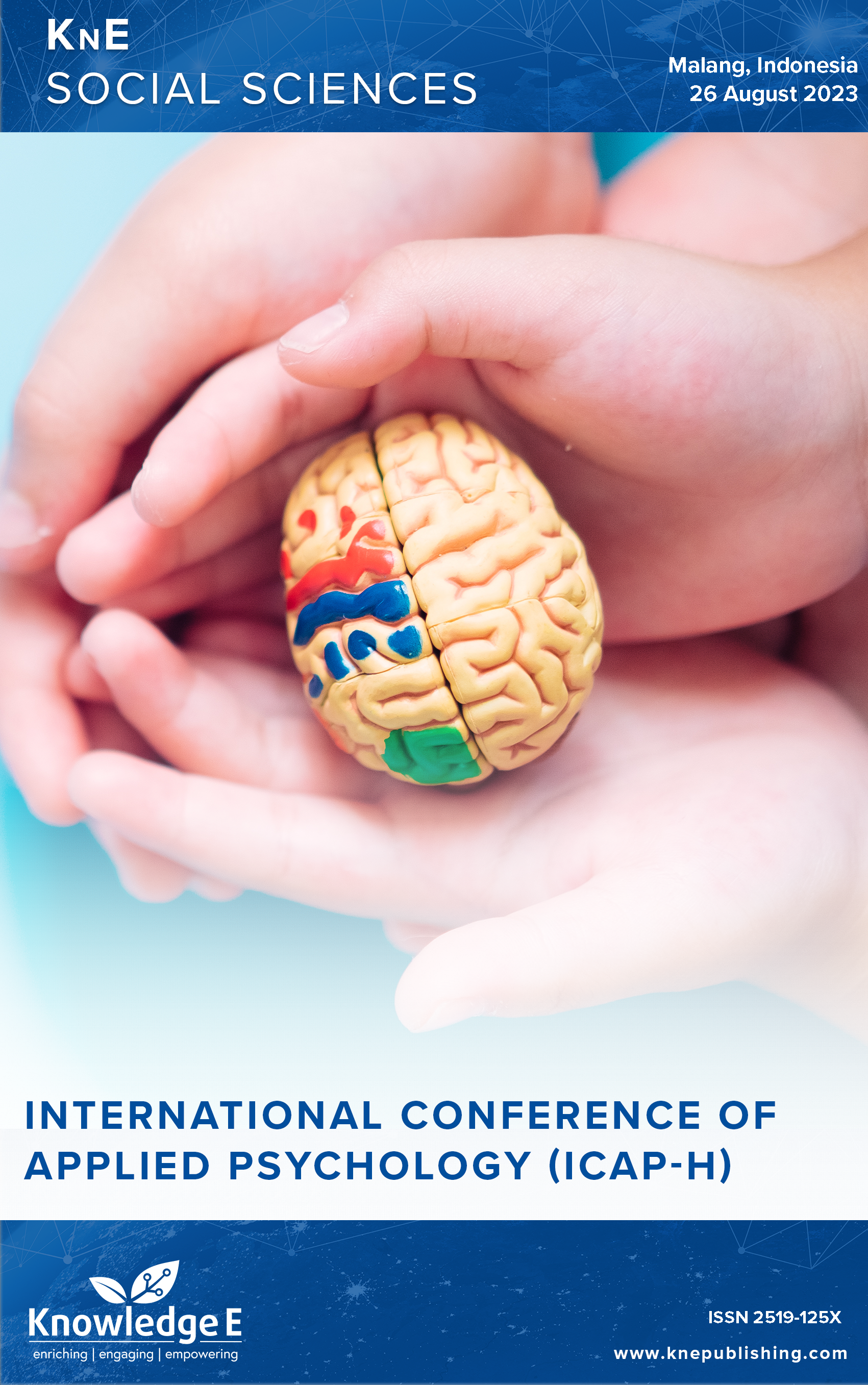Psychoeducation For Parents and Shadow Teachers: Managing Tantrum Behavior in Children With Special Needs
DOI:
https://doi.org/10.18502/kss.v9i5.15203Abstract
Tantrum behavior in children with special needs represents challenging behavior with deliberate intent and purpose. This tantrum behavior manifests within the school environment and frequently emerges at home. This behavior often leaves parents overwhelmed by ineffective management. Tantrum behavior impacts the child’s learning experience within the school setting. Limited understanding of tantrum behavior management among parents and shadow teachers can lead to either neglect or inadvertent reinforcement of such tantrum behaviors. Given the pivotal roles of parents as primary educators at home and shadow teachers as companions within the school, both play as agents of change in molding the child’s adaptive capabilities. This research aims to support parents and teachers in enhancing their comprehension of managing tantrum behaviors in children with special needs through psychoeducational interventions. The research participants comprise a community of parents and shadow teachers associated with children with special needs at an inclusive school in Malang City. This study presents an experimental approach using a one-group pretest and posttest design. The intervention outcomes reveal a highly significant distinction between the scores of tantrum behavior management knowledge before and after undergoing psychoeducational intervention (Z = –4.160; P = 0.000). Knowledge regarding tantrum behavior management after participating in psychoeducational interventions falls within the “high” category (68.2%). According to research participants, the perceived usefulness of psychoeducational interventions is gauged as somewhat beneficial (45.5%) and highly beneficial (54%). The subjects’ perception of the feasibility of implementing psychoeducational interventions varies, with a high level of confidence (36.4%), a moderate level of confidence (50%), and a sense of uncertainty or doubt (13.6%). Keywords: community, parents of children with special needs, psychoeducation,
References
Daniels E, Mandleco B, Luthy KE. Assessment, management, and prevention of childhood temper tantrums. Journal of the American Association of Nurse Practitioners. 2012;24(10):569–573. doi: 10.1111/j.1745-7599.2012.00755.x DOI: https://doi.org/10.1111/j.1745-7599.2012.00755.x
Potegal M, Davidson RJ. Temper tantrums in young children: 1. Behavioral composition. Journal of Developmental and Behavioral Pediatrics. 2003;24(3):140– 147. DOI: https://doi.org/10.1097/00004703-200306000-00002
Behavior TT. Description of parent knowledge and temper tantrum behavior. 2022;22:37–48.
Vuckovic S, Rucevic S, Ajdukovic M. Parenting style and practices and children’s externalizing behaviour problems: Mediating role of children’s executive functions. European Journal of Developmental Psychology. 2021;18(3):313–329. DOI: https://doi.org/10.1080/17405629.2020.1768067
Pellicano E. The development of executive function in autism. Autism Research and Treatment. 2012;2012:146132. DOI: https://doi.org/10.1155/2012/146132
Lehto, JE, Juujärvi P, Kooistra L, Pulkkinen L. Dimensions of executive functioning: Evidence from children. British Journal of Developmental Psychology. 2003;21(1):59–80. Available from: http://sfx.scholarsportal.info/laurier?url_ver= Z39.88-2004&rft_val_fmt=info:ofi/fmt:kev:mtx:journal&genre=unknown&sid=ProQ: ProQ%253Aneurosciabstracts&atitle=Dimensions+of+executive+functioning% 253A+Evidence+from+children&title=British+Journal+of+Developme DOI: https://doi.org/10.1348/026151003321164627
Patriquin MA. Evidence-based treatment and conceptualization of autism spectrum disorder: Emotion regulation, social impairment, and anxiety as targets. Bulletin of the Menninger Clinic. 2019;83(3):199–204. https://doi.org/10.1521/bumc.2019.83.3.199 DOI: https://doi.org/10.1521/bumc.2019.83.3.199
Patra S, Arun P, Chavan BS. Impact of psychoeducation intervention module on parents of children with autism spectrum disorders: A preliminary study. Journal of Neurosciences in Rural Practice. 2015;6(4):529–535. DOI: https://doi.org/10.4103/0976-3147.165422
Øien R, Eisemann MR. Brief report: Parent-reported problems related to communication, behavior and interests in children with autistic disorder and their impact on quality of life. Journal of Autism and Developmental Disorders. 2016;46(1):328–331. DOI: https://doi.org/10.1007/s10803-015-2577-4
Smith LE, Greenberg JS, Mailick MR. Adults with autism: Outcomes, family effects, and the multi-family group psychoeducation model. Current Psychiatry Reports. 2012;14(6):732–738. DOI: https://doi.org/10.1007/s11920-012-0328-1
Dijkhuis RR, Ziermans TB, Van Rijn S, Staal WG, Swaab H. Self-regulation and quality of life in high-functioning young adults with autism. Autism. 2017;21(7):896–906. DOI: https://doi.org/10.1177/1362361316655525
Bronfenbrenner U. The ecology of human development. Experiments by nature and design. London: Harvard University Press; 1979. DOI: https://doi.org/10.4159/9780674028845
Ashiabi GS, O’Neal KK. Child social development in context: An examination of some propositions in Bronfenbrenner’s bioecological theory. SAGE Open. 2015;5(2): https://doi.org/10.1177/2158244015590840 DOI: https://doi.org/10.1177/2158244015590840
Vélez-Agosto NM, Soto-Crespo JG, Vizcarrondo-Oppenheimer M, Vega-Molina S, García Coll C. Bronfenbrenner’s bioecological theory revision: Moving culture from the macro into the micro. Perspectives on Psychological Science. 2017;12(5):900– 910. DOI: https://doi.org/10.1177/1745691617704397
Supratiknya A. Merancang program dan modul psikoedukasi, edisi revi. Jakarta: Universitas Sanata Darma; 2011.
Bearss K, Burrell TL, Stewart L, Scahill L. Parent training in autism spectrum disorder: What’s in a Name? Clinical Child and Family Psychology Review. 2015;18(2):170–182. DOI: https://doi.org/10.1007/s10567-015-0179-5
Bahasa KP. Kamus Bahasa Indonesia. Jakarta: Pusat Bahasa. Departemen Pendidikan Nasional; 2008.
Joan Mc Kenna K. Beyond Behaviour Management for managing behavioural difficulties in individuals with an Autism Spectrum Disorder. Perth Western Australia: Autism Association of Western Australia (Inc); 2007.
Samson AC, Hardan AY, Podell RW, Phillips JM, Gross JJ. Emotion regulation in children and adolescents with autism spectrum disorder. Autism Research. 2015;8(1):9–18. DOI: https://doi.org/10.1002/aur.1387
Irianti B. Knowledge relationships mother with temper tantrum behavior in children in Puskesmas Payung Sekaki Pekanbaru 2019. Journal of Nurse-Midwifery. 2019;2(1):139–143.
Latipun, Psikologi eksperimen, Edisi Keli. Malang: UMM Press; 2015.
Barlow J, Bergman H, Kornør H, Wei Y, Bennett C. Group-based parent training programmes for improving emotional and behavioural adjustment in young children. Cochrane Database of Systematic Reviews. 2016;2016(8):CD003680. https://doi.org/10.1002/14651858.CD003680.pub3 DOI: https://doi.org/10.1002/14651858.CD003680.pub3
Akhani A, Dehghani M, Gharraee B, Hakim Shooshtari M. Parent training intervention for autism symptoms, functional emotional development, and parental stress inchildren with autism disorder: A randomized clinical trial. Asian Journal of Psychiatry. 2021;62(February):102735. DOI: https://doi.org/10.1016/j.ajp.2021.102735
Drakenberg M, Malmgren TV. “School principals’ perceptions of ‘basic values’ in the Swedish compulsory school system in regard to bronfenbrenner’s ecological systems theory.” Citizenship, Social and Economics Education. 2013;12(2):118–128. DOI: https://doi.org/10.2304/csee.2013.12.2.118
Latipun, Psikologi Eksperimen, Edisi Ketiga. Malang: UMM Press; 2015.
Mermelshtine R. Parent-child learning interactions: A review of the literature on scaffolding. British Journal of Educational Psychology. 2017;87(2):241–254. DOI: https://doi.org/10.1111/bjep.12147
Nawangsari SA. Psikoedukasi Pengasuhan untuk Meningkatkan Pengetahuan Orang Tua Penyandang Disabilitas. Procedia : Studi Kasus dan Intervensi Psikologi. 2022;10(3):88–92. 110.22219/procedia.v10i3.19217 DOI: https://doi.org/10.22219/procedia.v10i3.19217
Miranda A, Berenguer C, Roselló B, Baixauli I. Relationships between the social communication questionnaire and pragmatic language, socialization skills, and behavioral problems in children with autism spectrum disorders. Applied Neuropsychology: Child. 2020;9(2):141–152. DOI: https://doi.org/10.1080/21622965.2018.1550403

